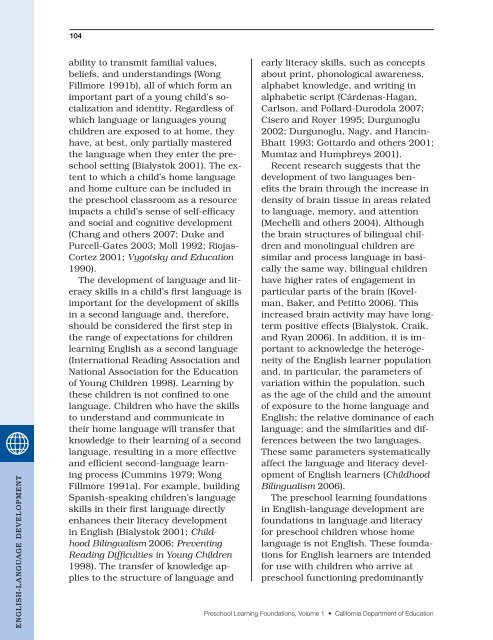California Preschool Learning Foundations - ECEZero2Three ...
California Preschool Learning Foundations - ECEZero2Three ...
California Preschool Learning Foundations - ECEZero2Three ...
You also want an ePaper? Increase the reach of your titles
YUMPU automatically turns print PDFs into web optimized ePapers that Google loves.
ENGLISH-LANGUAGE DEVELOPMENT<br />
104<br />
ability to transmit familial values,<br />
beliefs, and understandings (Wong<br />
Fillmore 1991b), all of which form an<br />
important part of a young child’s socialization<br />
and identity. Regardless of<br />
which language or languages young<br />
children are exposed to at home, they<br />
have, at best, only partially mastered<br />
the language when they enter the preschool<br />
setting (Bialystok 2001). The extent<br />
to which a child’s home language<br />
and home culture can be included in<br />
the preschool classroom as a resource<br />
impacts a child’s sense of self-efficacy<br />
and social and cognitive development<br />
(Chang and others 2007; Duke and<br />
Purcell-Gates 2003; Moll 1992; Riojas-<br />
Cortez 2001; Vygotsky and Education<br />
1990).<br />
The development of language and literacy<br />
skills in a child’s first language is<br />
important for the development of skills<br />
in a second language and, therefore,<br />
should be considered the first step in<br />
the range of expectations for children<br />
learning English as a second language<br />
(International Reading Association and<br />
National Association for the Education<br />
of Young Children 1998). <strong>Learning</strong> by<br />
these children is not confined to one<br />
language. Children who have the skills<br />
to understand and communicate in<br />
their home language will transfer that<br />
knowledge to their learning of a second<br />
language, resulting in a more effective<br />
and efficient second-language learning<br />
process (Cummins 1979; Wong<br />
Fillmore 1991a). For example, building<br />
Spanish-speaking children’s language<br />
skills in their first language directly<br />
enhances their literacy development<br />
in English (Bialystok 2001; Childhood<br />
Bilingualism 2006; Preventing<br />
Reading Difficulties in Young Children<br />
1998). The transfer of knowledge applies<br />
to the structure of language and<br />
early literacy skills, such as concepts<br />
about print, phonological awareness,<br />
alphabet knowledge, and writing in<br />
alphabetic script (Cárdenas-Hagan,<br />
Carlson, and Pollard-Durodola 2007;<br />
Cisero and Royer 1995; Durgunoglu<br />
2002; Durgunoglu, Nagy, and Hancin-<br />
Bhatt 1993; Gottardo and others 2001;<br />
Mumtaz and Humphreys 2001).<br />
Recent research suggests that the<br />
development of two languages benefits<br />
the brain through the increase in<br />
density of brain tissue in areas related<br />
to language, memory, and attention<br />
(Mechelli and others 2004). Although<br />
the brain structures of bilingual children<br />
and monolingual children are<br />
similar and process language in basically<br />
the same way, bilingual children<br />
have higher rates of engagement in<br />
particular parts of the brain (Kovelman,<br />
Baker, and Petitto 2006). This<br />
increased brain activity may have longterm<br />
positive effects (Bialystok, Craik,<br />
and Ryan 2006). In addition, it is important<br />
to acknowledge the heterogeneity<br />
of the English learner population<br />
and, in particular, the parameters of<br />
variation within the population, such<br />
as the age of the child and the amount<br />
of exposure to the home language and<br />
English; the relative dominance of each<br />
language; and the similarities and differences<br />
between the two languages.<br />
These same parameters systematically<br />
affect the language and literacy development<br />
of English learners (Childhood<br />
Bilingualism 2006).<br />
The preschool learning foundations<br />
in English-language development are<br />
foundations in language and literacy<br />
for preschool children whose home<br />
language is not English. These foundations<br />
for English learners are intended<br />
for use with children who arrive at<br />
preschool functioning predominantly<br />
<strong>Preschool</strong> <strong>Learning</strong> <strong>Foundations</strong>, Volume 1 • <strong>California</strong> Department of Education
















